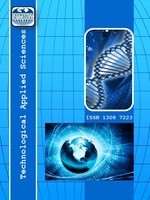AN ESTIMATE OF ENERGY CONSUMPTION FOR HOUSING BUILDINGS IN HOT CLIMATIC ZONES THROUGH ARTIFICAL INTELLIGENCE METHODS: CASE OF ANTALYA
Thermal Performance, Heating Load, Cooling Load, Thermal Insulation, Artificial Intelligence
___
- 1. Kaynaklı, O., (2008). A Study on Residential Heating Energy Requirement and Optimum Insulation Thickness. Renewable Energy, Volume:33, pp:1164-1172.
- 2. Chowdhury, A.A., Rasul, M.G., and Khan, M.M.K., (2008). Thermal-Comfort Analysis and Simulation for Various Low-Energy Cooling-Techonologies Applied to an Office Building in a Subtropical Climate. Applied Enegy, Volume:85, pp:449-462.
- 3. Al-Sanea, S. and Zedan M., (2011). Improving Thermal Performance of Building Walls by Optimizing Insulation Layer Distribution and Thickness for Same Thermal Mass. Applied Energy, Volume:88, pp:3113-3124.
- 4. Cheung, C.K., Fuller, R.J., and Luther, M.B., (2005). Energy-Efficient Envelope Design for High-Rise Apartments. Energy and Buildings, Volume:37, pp:37-48.
- 5. Baykal, C., (2014). Binalarda Yönlere Göre Yalıtım Kalınlığının Ekonomikliğinin Araştırılması. Master of Thesis, Natural&Applied Science, Yıldız Technical University, İstanbul.
- 6. Daouas, N., (2011). A Study on Optimum Insulation Thickness in Walls and Energy Savings in Tunisian Buildings Based on Analytical Calculation of Cooling and Heating Transmission Loads. Applied Energy, Volume:88, pp:156-164.
- 7. Tsanas, A. and Xifara, A., (2012). Accurate quantitative Estimation of Energy Performance of Residential Buildings Using Statistical Machine Learning Tools. Energy and Buildings, Volume:49, pp:560-567.
- 8. Maçka, S., Yaşar, Y., and Pehlevan, A., (2011). Investigating of the Effects on Building Energy Consumption and Life Cycle Cost of Building Envelope Alternatives. 12th International Conference on Durability of Building Materials and Component, Porto, Portugal.
- 9. General Directorate of Meteorology, Antalya Average Temperature Data, (2017. htpp://www.mgm.gov.tr.
- 10. Meteonorm, (2017). http://www.meteonorm.com/en/.
- 11. DesignBuilder Software, (2017). http://www.designbuilder.co.uk/.
- 12. Üstün O., (2009). Determination of Activation Functions in A Feedforward Neural Network by using Genetic Algorithm. Pamukkale Üniversitesi Mühendislik Bilimleri Dergisi, Volume:15, pp:225-234.
- 13. Kahraman, H.T., (2016). A Novel and Powerful Hybrid Classifier Method: Development and Testing of Heuristic k-nn Algorithm with Fuzzy Distance Metric. Data & Knowledge Engineering, Volume:103, pp:44-59.
- 14. Kahraman, H.T., Bayindir, R., and Sagiroglu, S., (2012). Applying A Genetic Algorithm-Based K-Nearest Neighbor Estimator For Estimating The Excitation Current and Parameter Weighting of Synchronous Motors. Energy Conversion and Management, (Submitted for publication) 2012.
- 15. Goldberg, D.E., (1989). Genetic Algorithms in Search Optimization and Machine Learning. Addison Wesley, Reading, pp:41.
- Başlangıç: 2009
- Yayıncı: E-Journal of New World Sciences Academy
TRABZON LİMANI ELLEÇLEME EKİPMANLARININ YAKIT TÜKETİM MALİYETLERİ ÜZERİNE BİR ARAŞTIRMA
SOLUTION OF ECONOMIC DISPATCH PROBLEM WITH THE VALVE-POINT LOAD EFFECT BY META-HEURISTIC ALGORITHMS
Mehmet Fatih TEFEK, Mehmet GÜÇYETMEZ, Harun UĞUZ
Kübra SÜMER HAYDARASLAN, Ersin HAYDARASLAN, Hamdi Tolga KAHRAMAN, Yalçın YAŞAR
BORU İÇİNE YERLEŞTİRİLEN KONİK TÜRBÜLATÖR SAYISININ NÜMERİK OPTİMİZASYONU
Bilal Sungur, Bahattin Topaloğlu
DÜNYADA VE TÜRKIYE’DE YENİLENEBİLLR ENERJİ KAYNAKLARININ DEĞERLENDİRİLMESİ
Kadir KAYA, Mahmut Can ŞENEL, Erdem KOÇ
DENİZE DEŞARJ YAPILARININ ÖĞRETME VE ÖĞRENME TABANLI ALGORITMAYLA OPTİMUM TASARIMI
Nurcan Öztürk, Hasan Tahsin Öztürk
GUSTAFSON-KESSEL AND FUZZY C-MEANS ALGORITHMS BY COLON CANCER DATA IN FUZZY CLUSTERING
